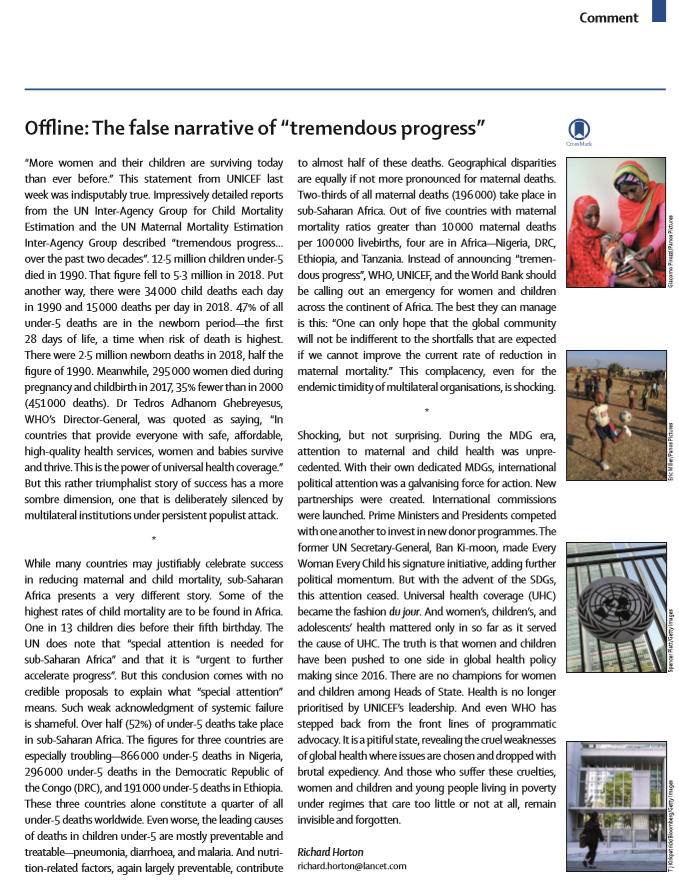This blog was originally published by The Lancet here.
By Richard Horton
“More women and their children are surviving today than ever before.” This statement from UNICEF last week was indisputably true. Impressively detailed reports from the UN Inter-Agency Group for Child Mortality Estimation and the UN Maternal Mortality Estimation Inter-Agency Group described “tremendous progress… over the past two decades”. 12·5 million children under-5 died in 1990. That figure fell to 5·3 million in 2018. Put another way, there were 34 000 child deaths each day in 1990 and 15 000 deaths per day in 2018. 47% of all under-5 deaths are in the newborn period—the first 28 days of life, a time when risk of death is highest. There were 2·5 million newborn deaths in 2018, half the figure of 1990. Meanwhile, 295 000 women died during pregnancy and childbirth in 2017, 35% fewer than in 2000 (451 000 deaths). Dr Tedros Adhanom Ghebreyesus, WHO’s Director-General, was quoted as saying, “In countries that provide everyone with safe, affordable, high-quality health services, women and babies survive and thrive. This is the power of universal health coverage.” But this rather triumphalist story of success has a more sombre dimension, one that is deliberately silenced by multilateral institutions under persistent populist attack.
While many countries may justifiably celebrate success in reducing maternal and child mortality, sub-Saharan Africa presents a very different story. Some of the highest rates of child mortality are to be found in Africa. One in 13 children dies before their fifth birthday. The UN does note that “special attention is needed for sub-Saharan Africa” and that it is “urgent to further accelerate progress”. But this conclusion comes with no credible proposals to explain what “special attention” means. Such weak acknowledgment of systemic failure is shameful. Over half (52%) of under-5 deaths take place in sub-Saharan Africa. The figures for three countries are especially troubling—866 000 under-5 deaths in Nigeria, 296 000 under-5 deaths in the Democratic Republic of the Congo (DRC), and 191 000 under-5 deaths in Ethiopia. These three countries alone constitute a quarter of all under-5 deaths worldwide. Even worse, the leading causes of deaths in children under-5 are mostly preventable and treatable—pneumonia, diarrhoea, and malaria. And nutrition-related factors, again largely preventable, contribute to almost half of these deaths. Geographical disparities are equally if not more pronounced for maternal deaths. Two-thirds of all maternal deaths (196 000) take place in sub-Saharan Africa. Out of five countries with maternal mortality ratios greater than 10 000 maternal deaths per 100 000 livebirths, four are in Africa—Nigeria, DRC, Ethiopia, and Tanzania. Instead of announcing “tremendous progress”, WHO, UNICEF, and the World Bank should be calling out an emergency for women and children across the continent of Africa. The best they can manage is this: “One can only hope that the global community will not be indifferent to the shortfalls that are expected if we cannot improve the current rate of reduction in maternal mortality.” This complacency, even for the endemic timidity of multilateral organisations, is shocking.
Shocking, but not surprising. During the MDG era, attention to maternal and child health was unprecedented. With their own dedicated MDGs, international political attention was a galvanising force for action. New partnerships were created. International commissions were launched. Prime Ministers and Presidents competed with one another to invest in new donor programmes. The former UN Secretary-General, Ban Ki-moon, made Every Woman Every Child his signature initiative, adding further political momentum. But with the advent of the SDGs, this attention ceased. Universal health coverage (UHC) became the fashion du jour. And women’s, children’s, and adolescents’ health mattered only in so far as it served the cause of UHC. The truth is that women and children have been pushed to one side in global health policy making since 2016. There are no champions for women and children among Heads of State. Health is no longer prioritised by UNICEF’s leadership. And even WHO has stepped back from the front lines of programmatic advocacy. It is a pitiful state, revealing the cruel weaknesses of global health where issues are chosen and dropped with brutal expediency. And those who suffer these cruelties, women and children and young people living in poverty under regimes that care too little or not at all, remain invisible and forgotten.
